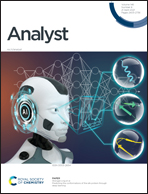A novel microfluidic system for the sensitive and cost-effective detection of okadaic acid in mussels†
Abstract
Okadaic acid (OA) is produced by marine dinoflagellates and it can be easily accumulated in shellfish, causing intoxications when consumed by humans. Consequently, there is a need for sensitive, reliable and cost-effective methods to detect OA in real samples. In this work, we developed a novel and affordable microfluidic system to detect OA based on the protein phosphatase 1 inhibition colorimetric assay. This enzyme was immobilized in a microfluidic chamber by physisorption in an alumina sol–gel. The results show good enzyme stability over time when maintained at 4 °C. The developed system was sensitive for OA standard solutions, presenting a limit of detection (LOD) of 11.6 nM over a large linear range (43.4 to 3095.8 nM). Our method revealed an LOD as low as 0.2 μg kg−1 and a linear range between 1.47 and 506 μg kg−1 for extracted mussel matrix, detecting OA concentrations in contaminated mussels much lower than the regulated limit (160 μg kg−1). The enzyme stability and reusability along with the simplicity and low cost associated with microfluidics systems make this method very interesting from a commercial point of view.



 Please wait while we load your content...
Please wait while we load your content...